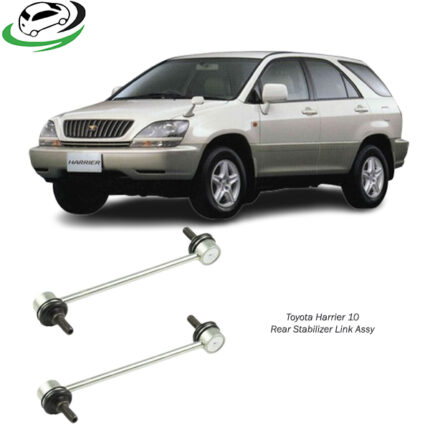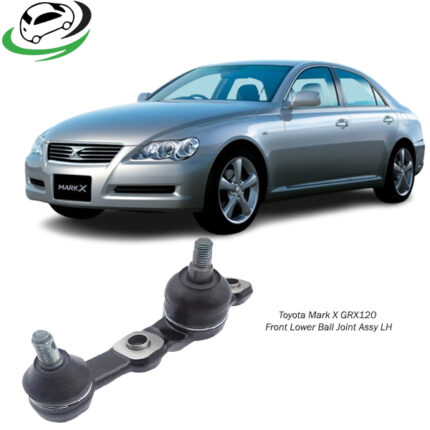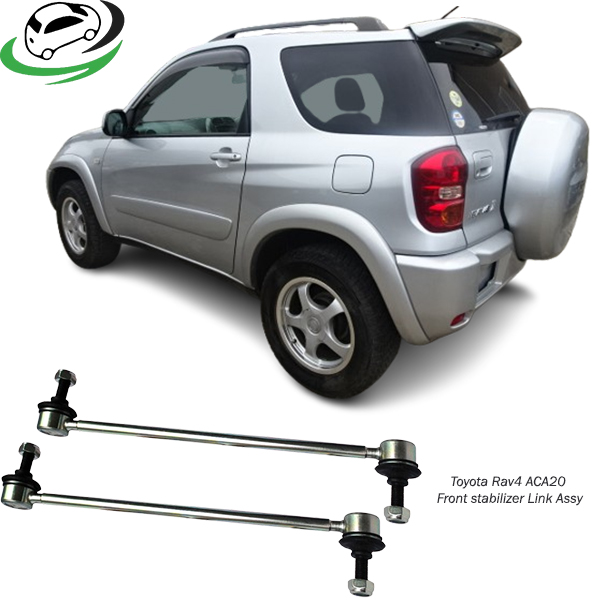-25%
Get Toyota Rav4 ACA20 Front stabilizer Link Assy 48820-42020 in Kenya
The primary function of the stabilizer link assembly is to connect the sway bar to the control arms or the suspension struts. When a vehicle navigates a turn, the suspension on the outside of the turn compresses while the suspension on the inside extends. The sway bar, connected by the stabilizer links, twists and resists this movement, reducing body roll and keeping the vehicle more level.
Here’s a step-by-step breakdown of the operation:
- Straight Driving: On a flat, straight road, the stabilizer bar and links remain relatively neutral, allowing the suspension to move independently.
- Cornering: During a turn, the outer suspension compresses and the inner suspension extends. The stabilizer bar twists, and the stabilizer links transmit this motion, applying force to the suspension components to counteract body roll.
- Uneven Surfaces: When driving over bumps or potholes, the stabilizer links help to distribute forces across the suspension, improving ride comfort and stability.
Materials and Manufacturing
Stabilizer link assemblies are typically made from high-strength steel or aluminum to ensure durability and resistance to the stresses encountered during driving. The ball joints and bushings are usually made from materials designed to handle wear and tear, such as hardened steel and high-quality rubber or polyurethane.
The manufacturing process involves:
- Forging or Machining: The rod and ball joints are usually forged or machined from solid metal to achieve the required strength and precision.
- Heat Treatment: Components undergo heat treatment to enhance their strength and durability.
- Surface Treatment: Corrosion-resistant coatings, such as zinc plating or powder coating, are applied to protect the assembly from rust and wear.
- Assembly: The various parts are assembled, with bushings and ball joints pressed or threaded into place. Fasteners are included as part of the assembly process.
Benefits of Stabilizer Link Assy;
1. Enhanced Handling and Stability
One of the primary benefits of the stabilizer link assembly is the enhancement of vehicle handling and stability. When a vehicle navigates turns or corners, the body tends to roll due to the centrifugal force. The stabilizer link helps to transfer the force from one side of the suspension to the other, reducing body roll and maintaining a level ride height. This results in:
- Improved Cornering Performance: By minimizing body roll, the stabilizer link allows for more predictable and stable cornering. This enhances driver confidence and control, especially during sharp turns or sudden maneuvers.
- Consistent Tire Contact: Maintaining better tire contact with the road surface during turns helps in achieving optimal grip and traction, which is crucial for both performance and safety.
2. Increased Ride Comfort
The stabilizer link assembly plays a role in absorbing and distributing shocks from uneven road surfaces. This leads to:
- Smoother Ride: By reducing the amount of roll and sway, the stabilizer link helps to smooth out the ride, making it more comfortable for passengers.
- Vibration Reduction: The assembly also helps in dampening vibrations and jolts from potholes or rough terrain, contributing to a quieter and more comfortable cabin environment.
3. Enhanced Safety
Safety is a paramount concern for any vehicle, and the stabilizer link assembly contributes significantly to this aspect by:
- Better Control: Improved handling and stability mean that drivers can maintain better control over the vehicle, particularly in emergency situations or during evasive maneuvers.
- Reduced Risk of Rollover: By minimizing excessive body roll, the stabilizer link reduces the risk of rollovers, especially in taller vehicles such as SUVs and trucks.
4. Prolonged Suspension Component Life
The stabilizer link assembly aids in distributing forces more evenly across the suspension system. This distribution helps in:
- Reduced Wear and Tear: By preventing excessive movement and stress on individual suspension components, the stabilizer link helps in reducing wear and tear, thereby prolonging the life of these parts.
- Cost Savings: Prolonged component life translates to fewer replacements and repairs, leading to cost savings for the vehicle owner over time.
5. Improved Steering Response
A direct benefit of better handling and stability is improved steering response. The stabilizer link contributes to:
- Precise Steering: By maintaining the vehicle’s alignment and reducing body roll, the stabilizer link ensures that steering inputs are more directly translated into vehicle movement. This precision is crucial for both performance driving and everyday maneuvering.
- Predictability: A vehicle with a well-functioning stabilizer link assembly responds more predictably to steering inputs, making it easier to drive and control.
6. Optimized Performance in Various Driving Conditions
Whether driving on smooth highways, winding roads, or uneven terrains, the stabilizer link assembly optimizes the vehicle’s performance by:
- Adaptability: The assembly allows the suspension system to adapt to various driving conditions, providing consistent performance and comfort regardless of the road surface.
- Versatility: For vehicles that are used in a variety of environments – from urban streets to off-road trails – the stabilizer link ensures that the vehicle remains stable and comfortable.
7. Enhanced Driver Confidence
All the benefits mentioned above contribute to an overall enhancement in driver confidence. Knowing that the vehicle is stable, responsive, and safe allows drivers to focus more on the road and less on compensating for vehicle instability.
Signs of a worn out Stabilizer Link:
1. Clunking or Rattling Noise
One of the most noticeable signs of a worn-out stabilizer link is a clunking or rattling noise coming from the suspension area. This noise is typically heard when driving over bumps, potholes, or uneven surfaces. It occurs because the worn or damaged stabilizer link allows excessive movement, causing parts to knock against each other.
2. Poor Handling and Stability
A worn stabilizer link can significantly affect the vehicle’s handling and stability. You may notice:
- Increased Body Roll: The vehicle leans more than usual during turns or cornering, making it feel less stable.
- Less Responsive Steering: The vehicle may not respond as precisely to steering inputs, leading to a less controlled and more unpredictable driving experience.
3. Uneven Tire Wear
When the stabilizer link is compromised, it can cause uneven pressure and force distribution on the tires. This results in:
- Irregular Tire Wear Patterns: Certain areas of the tires wear out faster than others, reducing the overall lifespan of the tires.
- Frequent Tire Replacement: Uneven wear necessitates more frequent tire replacements, increasing maintenance costs.
4. Swaying or Wandering
A faulty stabilizer link can cause the vehicle to sway or wander, especially at higher speeds. This swaying motion is due to the reduced ability of the stabilizer bar to control lateral movements. Drivers might feel the vehicle drifting or moving side-to-side without steering input, which can be particularly noticeable in windy conditions or when passing large vehicles.
5. Visible Damage
Sometimes, a visual inspection can reveal signs of a worn-out stabilizer link. Look for:
- Cracked or Split Bushings: Rubber or polyurethane bushings can degrade over time, leading to visible cracks or splits.
- Corrosion or Rust: Metal components of the stabilizer link can rust, especially in areas exposed to road salt and harsh weather conditions.
- Loose or Broken Parts: Check for any loose or disconnected parts that indicate wear or damage.
6. Difficulty in Cornering
If you notice that your vehicle struggles to maintain a level position during cornering or feels unstable, it could be due to a failing stabilizer link. The stabilizer link helps to keep the vehicle’s body level during turns, and when it’s worn out, this ability is compromised, leading to difficulty in maintaining a stable posture.
7. Excessive Vibration
Excessive vibration felt through the steering wheel or the body of the vehicle can also be a sign of a worn stabilizer link. This is due to the decreased ability of the suspension system to absorb and dampen vibrations from the road, leading to a rougher ride.
8. Alignment Issues
Persistent alignment issues can sometimes be traced back to a faulty stabilizer link. If you’ve had your vehicle aligned but still experience issues like the vehicle pulling to one side or uneven handling, it might be worth inspecting the stabilizer links.
Follow us on Facebook for more parts.



